J Sainsbury Bundle
How Did a Small Dairy Shop Become a UK Retail Giant?
Journey back in time to 1869, when John James Sainsbury and his wife Mary Ann opened a modest dairy shop in London, setting the stage for a retail revolution. Their commitment to "Quality perfect, prices lower" ignited a legacy that would transform the grocery landscape. This J Sainsbury SWOT Analysis can give you a better understanding of the company.
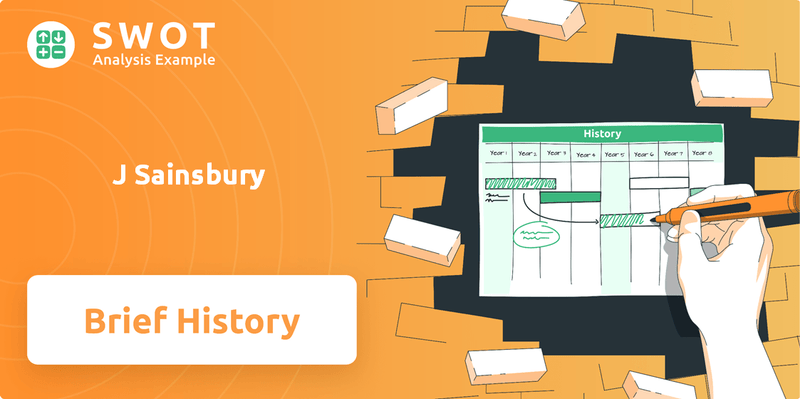
From its humble beginnings, the Sainsbury's company has consistently adapted, expanding from a single store to a vast network encompassing supermarkets, convenience stores, and online platforms. Explore the brief history Sainsbury and discover how Sainsbury's founder vision shaped the brand's evolution. Understanding the Sainsbury's timeline and the grocery store history provides valuable insights into its enduring success and its strategic direction in a competitive market.
What is the J Sainsbury Founding Story?
The brief history of J Sainsbury, a significant player in the UK's retail landscape, began in 1869. This journey started with a small dairy shop in London and evolved into one of the largest grocery chains in the United Kingdom. Understanding the early days of Sainsbury's provides key insights into its enduring success.
The story of the Sainsbury's company is a testament to entrepreneurial vision and adaptability. From its humble beginnings, the company expanded its offerings and geographical reach. The Sainsbury's timeline reflects a commitment to quality and customer service, which has defined its operations for over a century.
This chapter will explore the founding story of J Sainsbury, detailing its inception, early growth, and key milestones.
J Sainsbury history began on April 20, 1869, when John James Sainsbury and his wife, Mary Ann Sainsbury, opened their first dairy shop. The shop was located at 173 Drury Lane in Covent Garden, London.
- John James Sainsbury, born in 1844, had prior experience in the grocery trade.
- Mary Ann Sainsbury's background in her father's dairy business provided essential knowledge.
- Their business model focused on offering high-quality goods at affordable prices, a strategy encapsulated by their motto: 'Quality perfect, prices lower'.
- Initially, the shop sold milk, eggs, and butter.
The business quickly prospered, leading to expansion. In 1876, they opened a second shop in Queen's Crescent, Kentish Town. By 1882, the company had established its first depot, producing its own-brand bacon and hams. The first own-brand sausages were made at their Croydon branch. The firm was incorporated as a private company, J. Sainsbury Limited, in 1922, by which time it had become the UK's largest grocery retailer. For more insights into the company's strategic moves, consider reading about the Growth Strategy of J Sainsbury.
J Sainsbury SWOT Analysis
- Complete SWOT Breakdown
- Fully Customizable
- Editable in Excel & Word
- Professional Formatting
- Investor-Ready Format
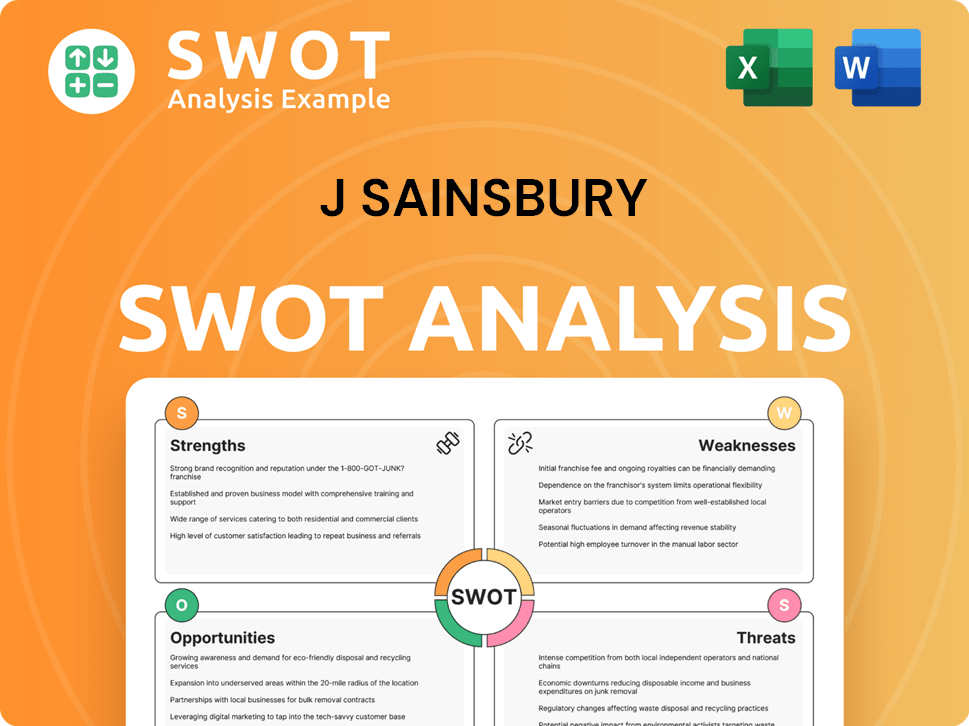
What Drove the Early Growth of J Sainsbury?
The early growth of J Sainsbury, a pivotal moment in the Grocery store history, was marked by rapid expansion. Starting from its initial location, the company quickly established multiple stores across London. This early phase laid the groundwork for what would become one of the UK's leading supermarket chains.
By 1881, Sainsbury's, a key part of the J Sainsbury history, had opened three additional stores in London. The first store outside of London opened in Croydon in 1882, which became its flagship store. This store was known for its high-quality products and commitment to cleanliness.
The company expanded its product range to include cheeses and poultry, and in 1903, introduced its own range of teas. By the time John James Sainsbury passed away in 1928, the company had grown to over 128 shops. This diversification was a key part of the company's growth strategy.
A significant milestone in Sainsbury's, part of the Sainsbury's company evolution, was the adoption of self-service supermarkets. The first self-service store opened in Croydon in 1950, revolutionizing the shopping experience. By 1969, own-brand products accounted for over 50% of its turnover.
J Sainsbury plc went public on July 12, 1973, marking the largest flotation on the London Stock Exchange at the time. During the 1970s, Sainsbury's expanded nationally, establishing stores in Yorkshire, Wales, Scotland, and Northern Ireland. This expansion solidified its position as a major retailer.
J Sainsbury PESTLE Analysis
- Covers All 6 PESTLE Categories
- No Research Needed – Save Hours of Work
- Built by Experts, Trusted by Consultants
- Instant Download, Ready to Use
- 100% Editable, Fully Customizable
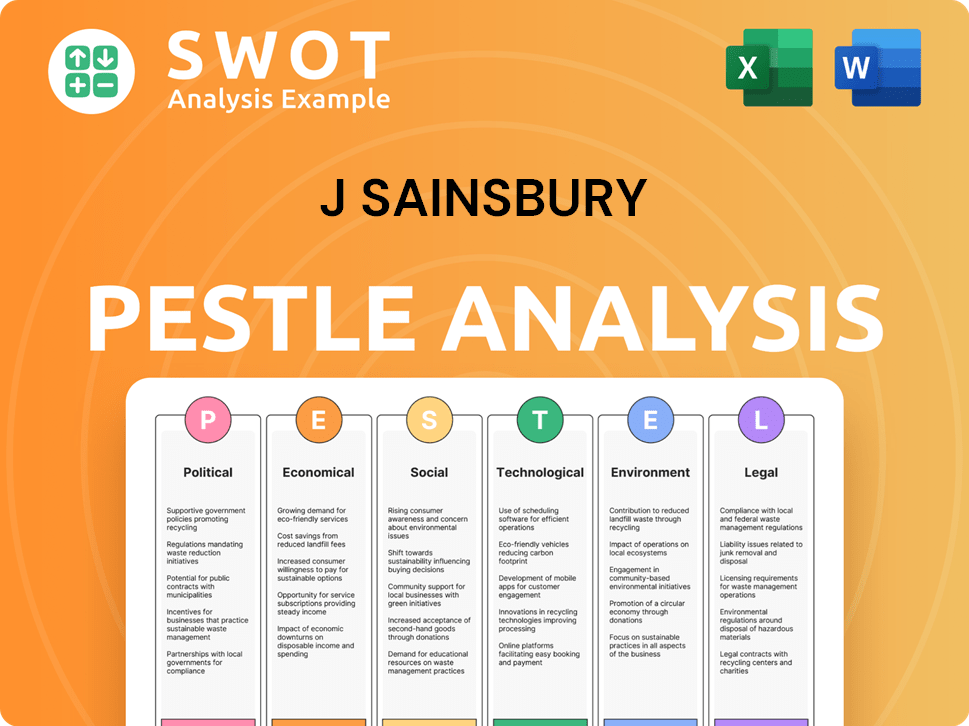
What are the key Milestones in J Sainsbury history?
The Marketing Strategy of J Sainsbury has been shaped by significant milestones. The early days of Sainsbury's saw the establishment of its first store and the subsequent expansion across the UK, marking the beginning of its journey as a major player in the grocery store history. This brief history of Sainsbury's highlights its evolution, key milestones, and adaptation to changing market dynamics.
| Year | Milestone |
|---|---|
| 1869 | John James Sainsbury and his wife Mary Ann opened their first store at 173 Drury Lane, London, establishing the foundation of Sainsbury's company. |
| 1922 | Sainsbury's became a public company, expanding its reach and influence in the retail sector. |
| 1950 | The introduction of self-service stores, starting with the Croydon branch, revolutionized the shopping experience. |
| 1962 | The establishment of an in-house Design Studio for packaging enhanced the brand's identity. |
| 1997 | Sainsbury's Bank was launched in partnership with Bank of Scotland, diversifying into financial services. |
Sainsbury's has consistently embraced innovation, particularly in its approach to retail. A key innovation was the introduction of self-service stores, transforming the way customers shopped.
The introduction of self-service stores in 1950, starting in Croydon, was a pivotal innovation. This approach significantly altered the customer experience.
Sainsbury's was a pioneer in developing own-brand goods. These products aimed to match national brands in quality while offering lower prices, enhancing value for customers.
In 1962, Sainsbury's established its own in-house Design Studio. This initiative enhanced brand identity and packaging design.
The launch of Sainsbury's Bank in 1997, in partnership with Bank of Scotland, was a strategic diversification. This move expanded the company's services beyond retail.
Under its 'Food First' strategy, Sainsbury's invested significantly in value, innovation, and service. This led to market share gains and increased grocery volumes.
The rollout of the Nectar Prices scheme, covering 6,000 products, provided significant savings for customers. This initiative enhanced customer loyalty.
Throughout its history, Sainsbury's has faced numerous challenges, including intense competition and market shifts. The company has had to adapt to changing consumer preferences and the rise of competitors.
In 1995, Tesco surpassed Sainsbury's to become the UK's largest grocery retailer. This marked a significant shift in the competitive landscape.
Sainsbury's faced challenges during market downturns and competitive threats. It was overtaken by Asda in market share from 2003 to 2014, and again briefly in 2019.
A proposed merger with Asda in 2018 was blocked by the Competition and Markets Authority. This decision was due to concerns about increased prices for consumers.
Sainsbury's has committed to ambitious sustainability targets. These include 100% sustainable cocoa in its own-brand products by 2025 and a 68% reduction in Scope 1 and 2 greenhouse gas emissions by 2030.
From March 2025, Sainsbury's plans to power 30 of its HGV trucks from its Bristol distribution center with biofuel created from its food waste. This will save over 3,000 tonnes of carbon dioxide annually.
Sainsbury's expanded its 'Aldi Price Match' to over 400 products. This initiative aims to offer competitive pricing and attract budget-conscious customers.
J Sainsbury Business Model Canvas
- Complete 9-Block Business Model Canvas
- Effortlessly Communicate Your Business Strategy
- Investor-Ready BMC Format
- 100% Editable and Customizable
- Clear and Structured Layout
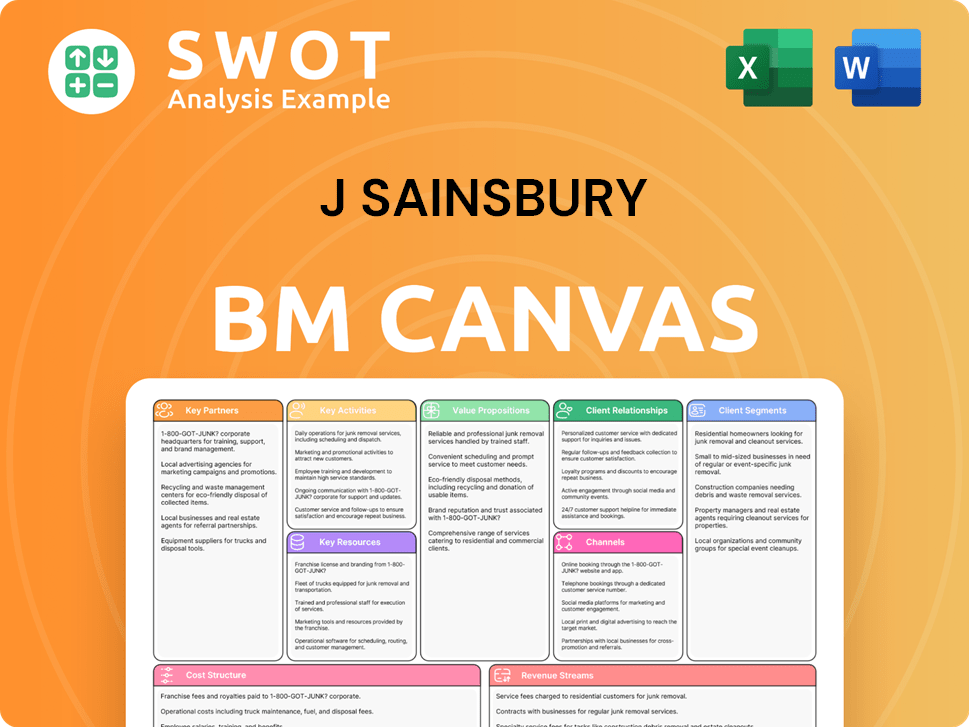
What is the Timeline of Key Events for J Sainsbury?
The story of J Sainsbury's history is a testament to its enduring presence in the UK retail landscape. From its humble beginnings as a dairy shop to becoming a major player in the grocery industry, Sainsbury's has continually adapted and evolved. The journey of the company, marked by strategic expansions, innovations, and responses to market dynamics, reflects its commitment to providing quality and value to its customers. This evolution is a fascinating case study in the grocery store history, highlighting its resilience and ability to stay relevant over the years.
| Year | Key Event |
|---|---|
| 1869 | John James and Mary Ann Sainsbury opened their first dairy shop in London. |
| 1882 | The first shop outside London opened, along with the establishment of a depot for own-brand bacon. |
| 1903 | Groceries were introduced, expanding the product range. |
| 1915 | John Benjamin Sainsbury joined his father as a partner. |
| 1922 | The firm was incorporated as J. Sainsbury Limited, becoming the largest grocery retailer in the UK. |
| 1950 | The first self-service store opened in Croydon. |
| 1973 | The company went public as J Sainsbury plc. |
| 1977 | The first SavaCentre hypermarket opened. |
| 1981 | The first Homebase home and garden center opened. |
| 1995 | Tesco surpassed Sainsbury's as the UK market leader. |
| 1997 | Sainsbury's Bank was launched. |
| 2016 | Sainsbury's acquired Home Retail Group, including Argos and Habitat. |
| 2018 | The planned merger with Asda was blocked. |
| 2024 | Retail sales reached £31.6 billion, up 3.1%, and retail underlying operating profit reached £1.0 billion, up 7.2%. |
| 2025 | Sainsbury's plans to use biofuel from food waste to power 30 trucks. |
Sainsbury's is focused on its 'Next Level' strategy to enhance earnings, boost free cash flow, and deliver greater returns for shareholders. The company is aiming to generate £1.6 billion in retail free cash flow by FY27. This strategy is a key part of Sainsbury's current status and future plans.
The company plans to invest £1 billion in lowering prices and expanding its store space. This includes opening 15 new supermarkets and 25 convenience stores in FY2025/26. The expansion is part of the company's effort to maintain its competitive position and adapt to changing consumer needs.
Sainsbury's is repurposing around 300,000 square feet of non-food space into food retail areas, complemented by the acquisition of ten former Homebase stores. Sustainability is also a priority, with targets to become net zero in its own operations by 2035 and its value chain by 2050.
The company is prioritizing automation and consolidating its logistics and warehouse infrastructure, with over 70% of sales now going through self-checkouts. With a strong balance sheet and a focus on customer experience, Sainsbury's aims to maintain its competitive position, continuing its evolution.
J Sainsbury Porter's Five Forces Analysis
- Covers All 5 Competitive Forces in Detail
- Structured for Consultants, Students, and Founders
- 100% Editable in Microsoft Word & Excel
- Instant Digital Download – Use Immediately
- Compatible with Mac & PC – Fully Unlocked
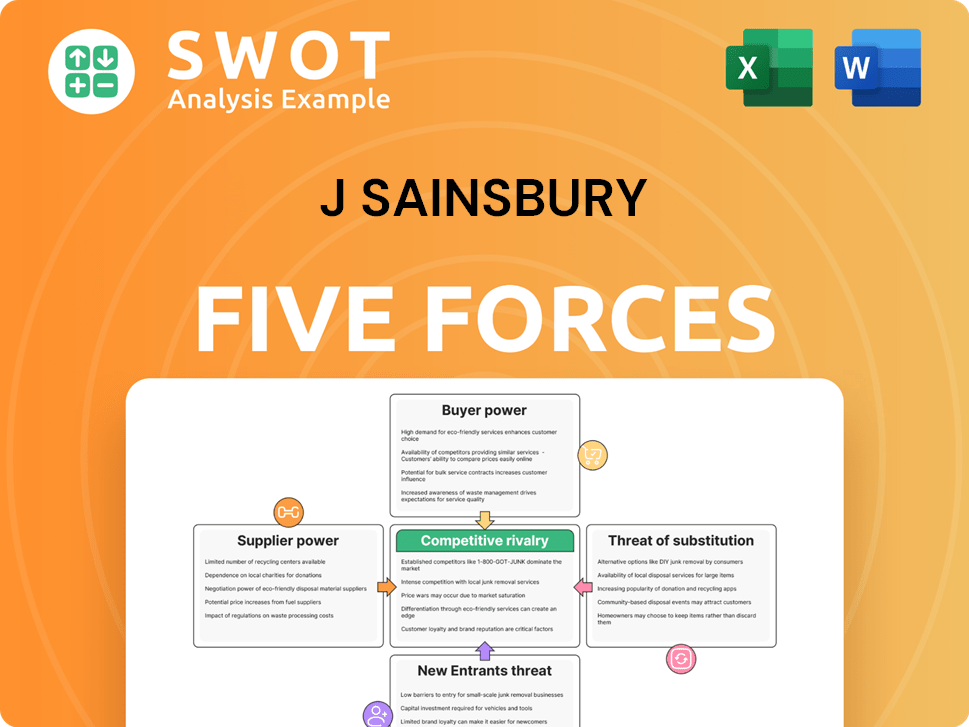
Related Blogs
- What is Competitive Landscape of J Sainsbury Company?
- What is Growth Strategy and Future Prospects of J Sainsbury Company?
- How Does J Sainsbury Company Work?
- What is Sales and Marketing Strategy of J Sainsbury Company?
- What is Brief History of J Sainsbury Company?
- Who Owns J Sainsbury Company?
- What is Customer Demographics and Target Market of J Sainsbury Company?
Disclaimer
All information, articles, and product details provided on this website are for general informational and educational purposes only. We do not claim any ownership over, nor do we intend to infringe upon, any trademarks, copyrights, logos, brand names, or other intellectual property mentioned or depicted on this site. Such intellectual property remains the property of its respective owners, and any references here are made solely for identification or informational purposes, without implying any affiliation, endorsement, or partnership.
We make no representations or warranties, express or implied, regarding the accuracy, completeness, or suitability of any content or products presented. Nothing on this website should be construed as legal, tax, investment, financial, medical, or other professional advice. In addition, no part of this site—including articles or product references—constitutes a solicitation, recommendation, endorsement, advertisement, or offer to buy or sell any securities, franchises, or other financial instruments, particularly in jurisdictions where such activity would be unlawful.
All content is of a general nature and may not address the specific circumstances of any individual or entity. It is not a substitute for professional advice or services. Any actions you take based on the information provided here are strictly at your own risk. You accept full responsibility for any decisions or outcomes arising from your use of this website and agree to release us from any liability in connection with your use of, or reliance upon, the content or products found herein.